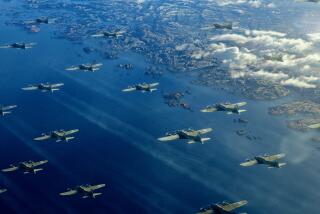Upgrades aim to extend B-52 bombersâ already long lives
For Air Force Capt. Daniel âSwoopâ Welch, flying a B-52 bomber has become the family business.
His father, retired Lt. Col. Don Welch, was trained to drop nuclear bombs with the aircraft during the height of the Cold War. His grandfather, retired Col. Don Sprague, flew B-52 combat missions in Vietnam.
âIt is definitely a testament to the robust design of the B-52,â said Welch, 28. âGetting to fly the same aircraft as my father and grandfather has been pretty cool.â
Despite the bomberâs more than half-century of service, the Air Force believes that modifications and overhauls have made the B-52 ageless. Now engineers and technicians are working on a contract worth up to $11.9 billion for an array of upgrades to bring the B-52 Stratofortress fleet into the 21st century.
The planeâs computers are only as powerful as the original PCs in the early 1980s. Bombing mission information has to be uploaded before a flight. It canât be changed in the air â even if the target on the ground changes.
Now Boeing is expanding on the bombersâ limited capabilities by providing an upgraded communications system so aircrews can send and receive information via satellite links. This enables the B-52âs five-person crews to change mission plans, re-target weapons in flight and interact better with ground forces and other aircraft.
Nobody can say for sure how many of the governmentâs 76 B-52s â down from 744 in the planeâs heyday â will survive three more decades. The most recent variant of the plane, built between 1960 and 1962, has undergone more than 30 major modifications.
Although the revisions have maintained the planeâs 185-foot wingspan and a length of nearly 160 feet, the guts of the B-52 have been continually revamped. For example, the World War II-era tail gunner position has been removed and new electronics have been installed, although some planes still have vacuum tubes.
Now the plane, which was designed on the back of a napkin over a weekend in 1948 by three Boeing employees, is getting modern digital display screens, computer network servers and real-time communication uplinks.
âItâs like taking your grandmotherâs old rotary phone and giving her the latest greatest smartphone,â said Col. John Johnson, chief of the Air Force Global Strike Commandâs bomber requirements division.
The B-52 was developed during the Korean War. It carpet-bombed during the Vietnam War. It ran crucial missions in Kosovo and the Middle East, and military strategists aim to keep it flying until at least 2040. Itâs still a large, lumbering aircraft, but over the years, the fleet has gotten new engines and technology. Built to carry nuclear weapons, it now drops GPS-guided smart bombs and bunker-busting munitions.
No other warplane in U.S. military history has been operational as long as the B-52. Other sophisticated military aircraft have come and gone, but the relatively low-tech B-52 has remained in the U.S. arsenal. It represents nearly half of all bombers in the fleet.
While the Pentagon struggles to rein in spending and battle cost overruns on programs such as the nearly $400-billion F-35 Joint Strike Fighter now in development, it must rely on proven war horses like the B-52.
Several bombers were developed to replace the B-52 in the last six decades, but not one matched its affordability and versatility. Many of the programs were canceled or cut short because of political pressures and budget concerns.
The B-52 has remained. With its iconic shape and vast power, the bomber has also found its way into pop culture as the name for a Kahlua-infused cocktail, a beehive hairdo for women in the 1960s and a New Wave rock band in the 1970s.
Although some military industry analysts say the B-52 fleet is so old that there are planes in danger of falling apart, the Air Force has poured billions of dollars into modernizing the fleet, and Boeing says the plane could fly well into its 100th year.
Military makeovers have become common. Boeing, like other military companies that were once focused on churning out new aircraft, has found that researching and developing new advanced parts for aging planes to be a lucrative business. Hundreds of engineers across Southern California are working at places such as Northrop Grumman Corp., Raytheon Co. and Lockheed Martin Corp. on upgrades to aging warplanes.
Michael A. Miller, an analyst with the Congressional Research Service, wrote this year that a potential problem with sustaining a fleet of aging bombers is a shrinking inventory of parts and supplies that are no longer made, difficult to find or costly to remake.
âWithout sufficient sustainment and modernization funding, many analysts argue the U.S. bomber fleet will quickly become a decrepit force ill-suited to the potential challenges posed by 21st century adversaries,â he said. âA question to be answered is whether the defense industrial base will even be capable of meeting the sustainment requirements of Americaâs legacy bomber force out to 2040.â
Because of the wear and tear on the aircraft from the demands of military flight, made worse by 11 years of continuous combat in the Middle East, the aging airframe structures need reinforcement, engines need to be replaced, and computer and electronic components need upgrading, Miller said.
But with all the upgrades, the Pentagon and Boeing insist that the B-52 bombers are more capable than ever. It is the only bomber in U.S. arsenal capable of dropping conventional and nuclear weapons as well as deploying long-range cruise missiles.
The Air Force has 63 B-1 Lancer bombers, which are capable of supersonic and low-level flight, and 20 B-2 Spirits, a stealthy bat-winged bomber that became fully operational in late 2003.
On the drawing board is the Air Forceâs new proposal for a new âLong-Range Strike Bomber.â But even if that program does move forward, flight-testing would not start until the mid-2020s, with initial operational capability near 2030.
Capt. Brandon Fischer, a 30-year-old B-52 pilot stationed at Barksdale Air Force Base in Louisiana, said that although a new bomber might be coming, the B-52 will still be flying high.
âItâs remarkable to think that youâre sitting in the same aircraft that was likely carrying nuclear bombs at some point during the Cold War,â he said. âWith all the improvements that are coming, itâll fly for another 30 years.â
Twitter: @wjhenn
More to Read
Inside the business of entertainment
The Wide Shot brings you news, analysis and insights on everything from streaming wars to production â and what it all means for the future.
You may occasionally receive promotional content from the Los Angeles Times.











